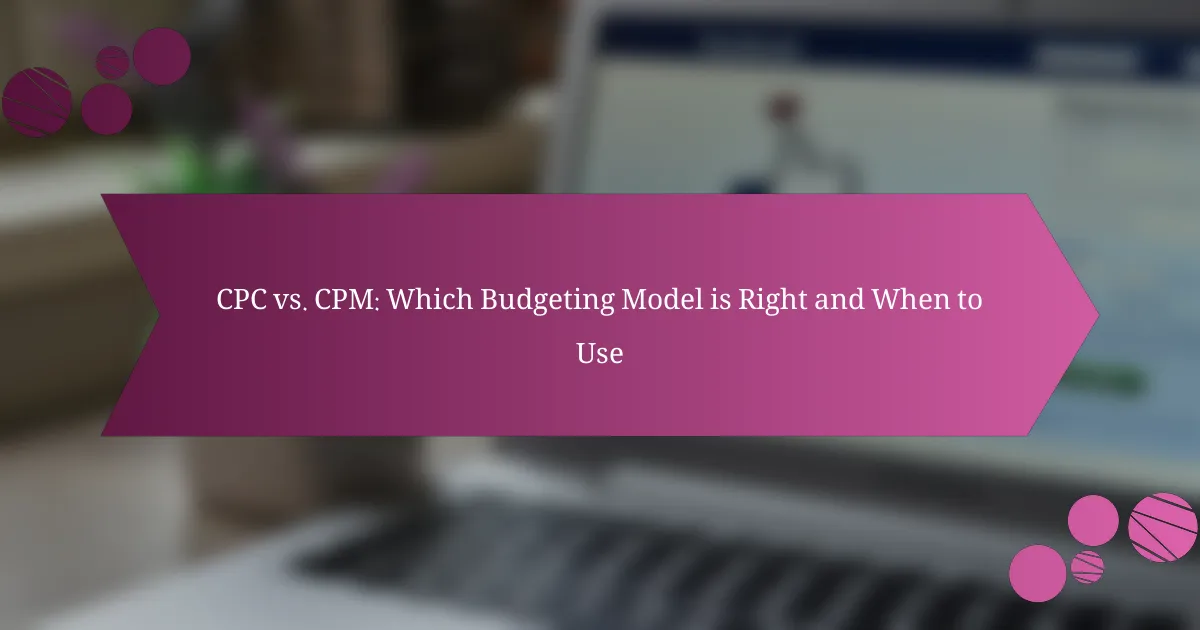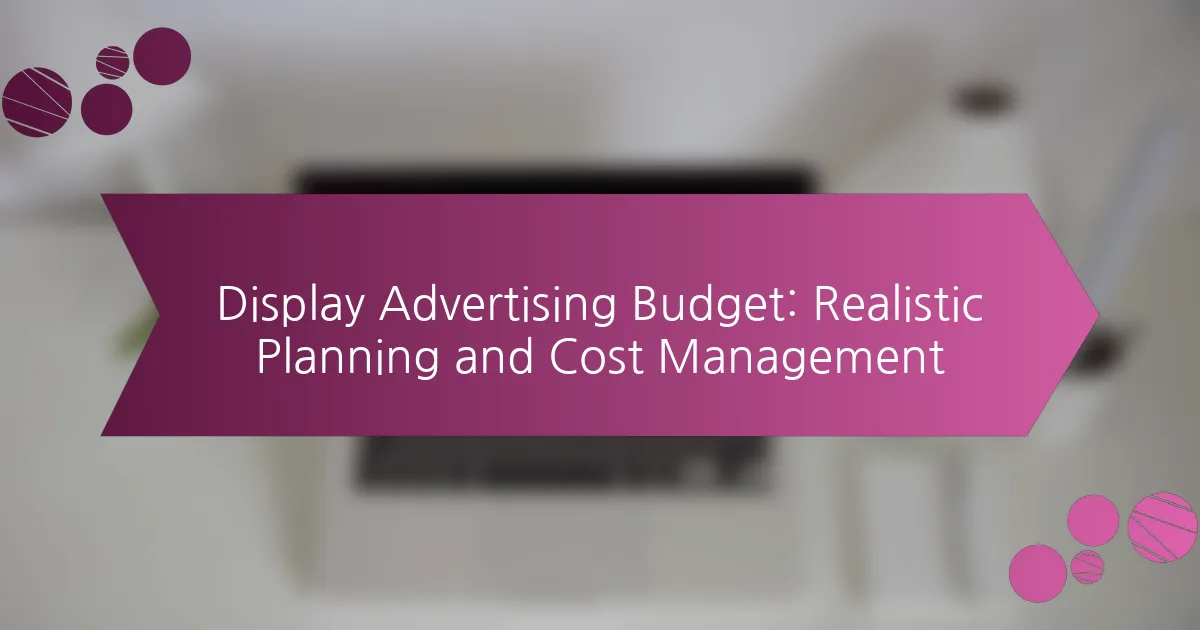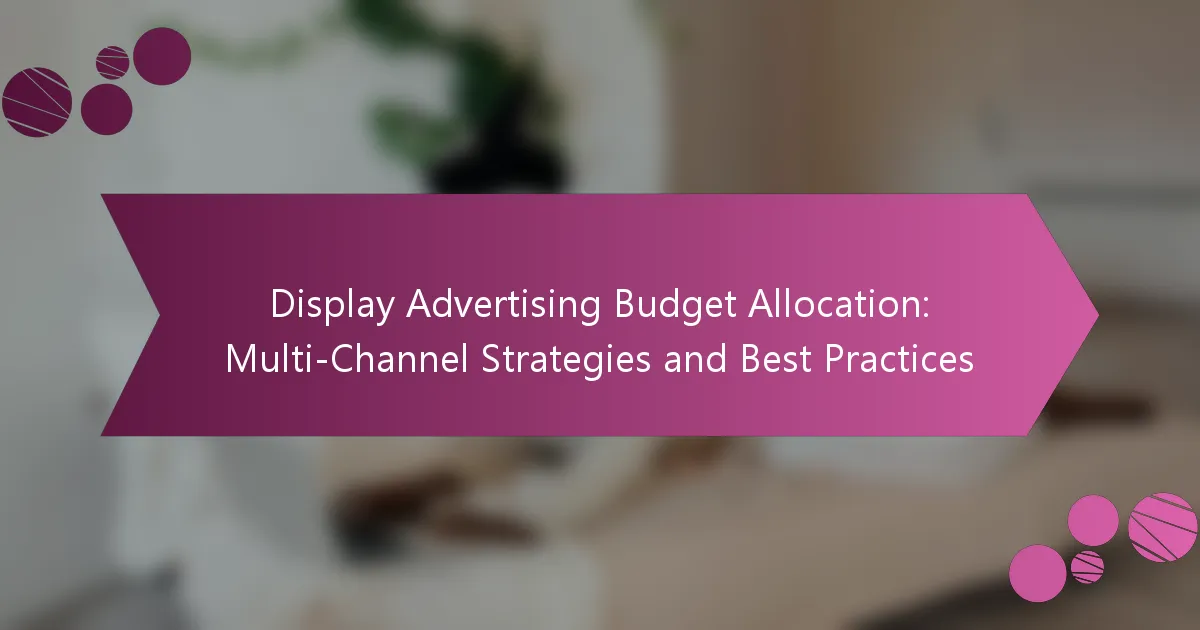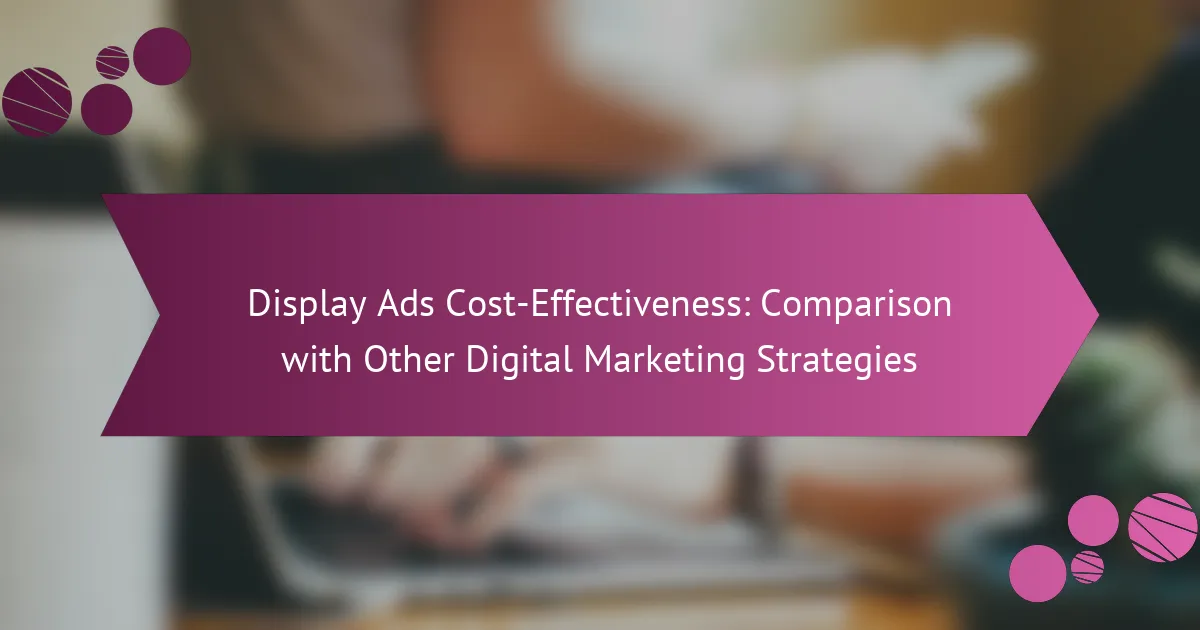Understanding the differences between CPC (cost-per-click) and CPM (cost-per-thousand impressions) is crucial for effective advertising budgeting. CPC is ideal for campaigns aimed at driving traffic and conversions, as advertisers pay only for actual clicks on their ads. In contrast, CPM is better suited for brand awareness initiatives, where the focus is on maximizing visibility through impressions rather than immediate user engagement.

What is the difference between CPC and CPM in display advertising?
CPC, or cost-per-click, and CPM, or cost-per-thousand impressions, are two distinct budgeting models in display advertising. CPC charges advertisers based on the number of clicks their ads receive, while CPM charges based on the number of impressions, or views, the ads generate.
CPC defined as cost-per-click
CPC, or cost-per-click, is a pricing model where advertisers pay each time a user clicks on their ad. This model is particularly effective for campaigns focused on driving traffic to a website or generating leads, as it directly ties costs to user engagement.
When using CPC, it’s essential to set a clear budget and bid strategy. Advertisers should monitor click-through rates (CTR) to ensure their ads are performing well. A common pitfall is underestimating the cost of competitive keywords, which can lead to overspending.
CPM defined as cost-per-thousand impressions
CPM, or cost-per-thousand impressions, charges advertisers based on the number of times their ad is displayed, regardless of whether users click on it. This model is ideal for brand awareness campaigns where the goal is to reach a large audience rather than drive immediate clicks.
When opting for CPM, consider the overall reach and frequency of your ads. It’s crucial to analyze the cost-effectiveness of impressions versus clicks, especially in industries where brand visibility is key. Advertisers should avoid focusing solely on impressions without assessing engagement metrics, as high impressions do not always equate to successful campaigns.
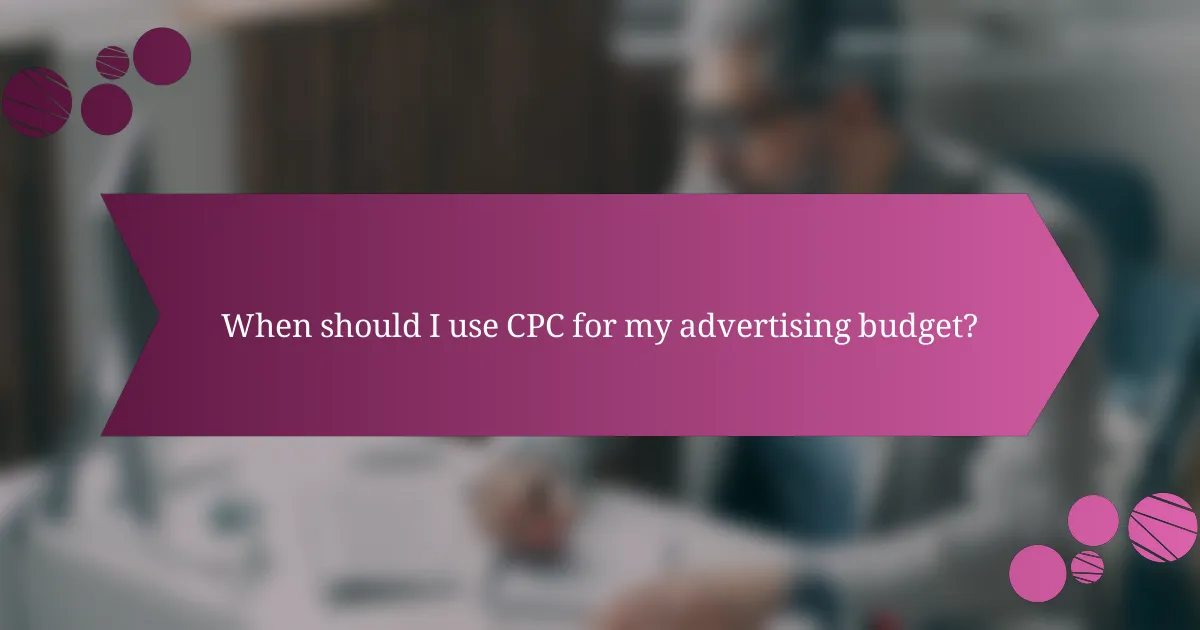
When should I use CPC for my advertising budget?
Use Cost Per Click (CPC) when your advertising budget is focused on driving traffic and conversions. This model is effective for campaigns where you want to pay only when users engage with your ads by clicking on them.
Best for performance-driven campaigns
CPC is particularly beneficial for performance-driven campaigns that prioritize measurable results. By paying only for actual clicks, you can directly link your spending to user engagement and conversion rates. This model allows for better budget control and optimization based on real-time performance data.
To maximize effectiveness, set clear goals for your campaign, such as a target cost per acquisition (CPA). Regularly analyze click-through rates (CTR) and adjust bids accordingly to ensure you are getting the most value from your budget.
Ideal for lead generation
CPC is an excellent choice for lead generation campaigns where capturing user interest is crucial. By focusing on clicks, you can attract potential customers to landing pages designed for conversion, such as sign-up forms or product inquiries. This approach often yields higher-quality leads compared to impressions alone.
Consider using targeted keywords and compelling ad copy to increase the likelihood of clicks. Additionally, monitor your conversion rates to ensure that the clicks you are paying for are translating into leads, and adjust your strategy as needed to improve overall performance.
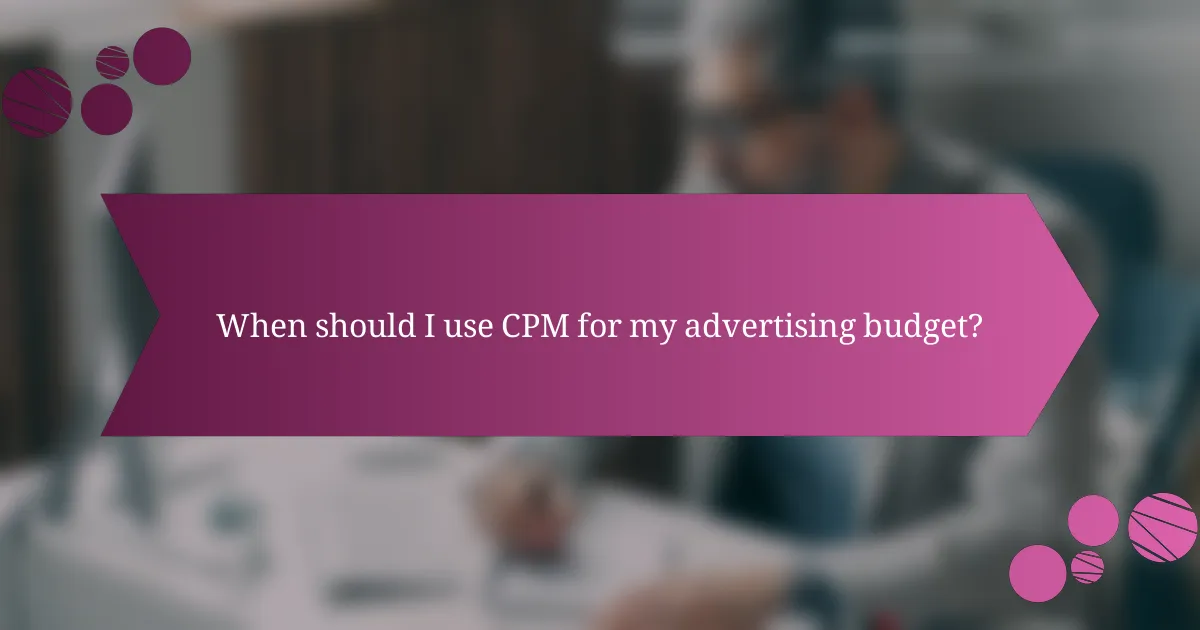
When should I use CPM for my advertising budget?
CPM, or cost per mille, is best used when your goal is to maximize visibility rather than immediate conversions. This model is particularly effective for campaigns focused on brand awareness, where impressions are more valuable than direct clicks.
Best for brand awareness campaigns
CPM is ideal for brand awareness campaigns because it allows advertisers to reach a large audience at a lower cost per impression. By prioritizing visibility, brands can establish recognition and recall among potential customers, which is crucial for long-term success.
When using CPM for brand awareness, consider targeting specific demographics or interests to ensure your ads are seen by the right audience. For instance, a company launching a new product might allocate a significant portion of their budget to CPM ads on social media platforms where their target demographic is most active.
Effective for high-traffic websites
Using CPM is particularly effective on high-traffic websites where the potential for impressions is significantly greater. Advertisers can benefit from the sheer volume of visitors, making it a cost-efficient way to gain exposure.
When selecting high-traffic sites for CPM campaigns, look for platforms that align with your brand’s values and target audience. For example, a fashion retailer might choose popular lifestyle blogs or fashion news sites to maximize their visibility among fashion-conscious consumers.
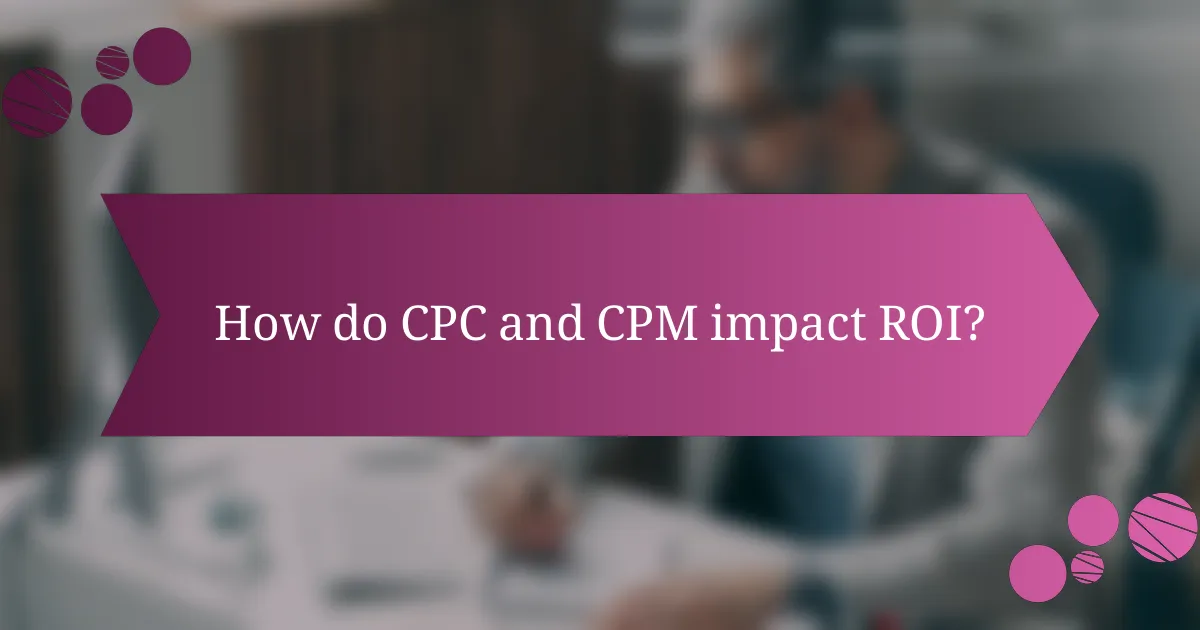
How do CPC and CPM impact ROI?
CPC (Cost Per Click) and CPM (Cost Per Mille) significantly influence return on investment (ROI) by determining how advertising budgets are allocated. CPC focuses on measurable engagement through clicks, while CPM emphasizes maximizing reach and visibility through impressions.
CPC offers measurable engagement
CPC is a budgeting model that charges advertisers each time a user clicks on their ad. This model is particularly effective for campaigns aimed at driving traffic to a website or generating leads. By focusing on clicks, advertisers can directly measure engagement and adjust their strategies based on performance.
For example, if an ad campaign costs $1 per click and generates 100 clicks, the total cost would be $100. This allows advertisers to calculate their ROI based on the revenue generated from those clicks. A common pitfall is not tracking conversions effectively, which can lead to misjudging the true value of the clicks.
CPM maximizes reach and visibility
CPM charges advertisers for every 1,000 impressions their ad receives, making it ideal for brand awareness campaigns. This model is beneficial when the goal is to reach a broad audience rather than drive immediate clicks. Advertisers can gain visibility across various platforms, increasing the likelihood of brand recognition.
For instance, if a CPM rate is $10, an ad that receives 50,000 impressions would cost $500. While this approach may not yield immediate engagement, it can enhance long-term brand recall. Advertisers should ensure they target the right audience to avoid wasting impressions on users unlikely to convert.

What are the advantages of using CPC?
Cost-per-click (CPC) advertising offers several advantages, particularly for businesses focused on driving targeted traffic to their websites. By paying only when users click on ads, advertisers can optimize their spending and achieve better returns on investment.
Cost efficiency for targeted traffic
CPC is particularly cost-efficient for campaigns aimed at specific audiences. Advertisers can set bids based on the value of clicks from particular demographics or interests, ensuring that their budget is directed towards the most relevant users. This model often results in a higher conversion rate compared to other pricing models.
For example, if a business is targeting a niche market, it can allocate a higher CPC for clicks from that segment, maximizing the chances of conversion while minimizing wasted ad spend on less relevant traffic.
Control over ad spend
With CPC, advertisers maintain better control over their ad budgets. They can set daily or monthly limits, ensuring they do not exceed their financial constraints. This flexibility allows for adjustments based on performance, enabling advertisers to scale successful campaigns while pausing or modifying underperforming ones.
Additionally, CPC campaigns can be monitored in real-time, allowing for quick decisions on bid adjustments or budget reallocations. This responsiveness is crucial for optimizing ad performance and maximizing ROI.

What are the advantages of using CPM?
Cost Per Mille (CPM) offers several advantages, particularly for advertisers focused on maximizing brand visibility. This model allows businesses to pay for every thousand impressions, making it ideal for campaigns aimed at reaching a large audience efficiently.
Higher impression volume
One of the primary benefits of using CPM is the potential for a higher impression volume. Advertisers can achieve extensive reach without being limited by clicks or conversions. This is especially useful for brand awareness campaigns where the goal is to get in front of as many eyes as possible.
For example, a company launching a new product may choose a CPM model to ensure their ads are displayed frequently across various platforms, increasing the likelihood of audience recognition. This approach can lead to significant brand exposure over a relatively short period.
Better for broad audience targeting
CPM is particularly effective for advertisers targeting a broad audience. This model allows for the delivery of ads to a wide demographic, making it easier to reach potential customers who may not yet be familiar with the brand. By focusing on impressions rather than specific actions, advertisers can cast a wider net.
For instance, a national campaign promoting a new beverage might utilize CPM to ensure the ads are seen by diverse groups across multiple states. This broad targeting can help build brand awareness and establish a presence in various markets, ultimately leading to increased sales over time.

What factors should I consider when choosing between CPC and CPM?
When choosing between CPC (Cost Per Click) and CPM (Cost Per Mille), consider your campaign goals, target audience, and budget. Each model serves different purposes and can significantly impact your advertising effectiveness and costs.
Campaign goals and objectives
Your campaign goals play a crucial role in determining whether to use CPC or CPM. If your primary objective is to drive traffic to your website or generate leads, CPC is often more effective as you only pay when someone clicks on your ad. Conversely, if brand awareness and visibility are your main goals, CPM may be the better choice since you pay for impressions, allowing your ad to be seen by a larger audience.
For example, a product launch might benefit from a CPM model to maximize exposure, while a limited-time offer would likely perform better under a CPC model to ensure clicks translate into immediate sales.
Target audience characteristics
Understanding your target audience is essential when deciding between CPC and CPM. If your audience is highly engaged and likely to click on ads, CPC can provide better ROI as you only pay for actual interactions. However, if your audience is broad and you want to build brand recognition, CPM can be more advantageous as it allows for widespread visibility.
Consider demographics, online behavior, and the platforms where your audience spends time. For instance, if your target market frequently uses social media, a CPM approach might enhance brand recall, while a search engine campaign could leverage CPC for immediate action from interested users.
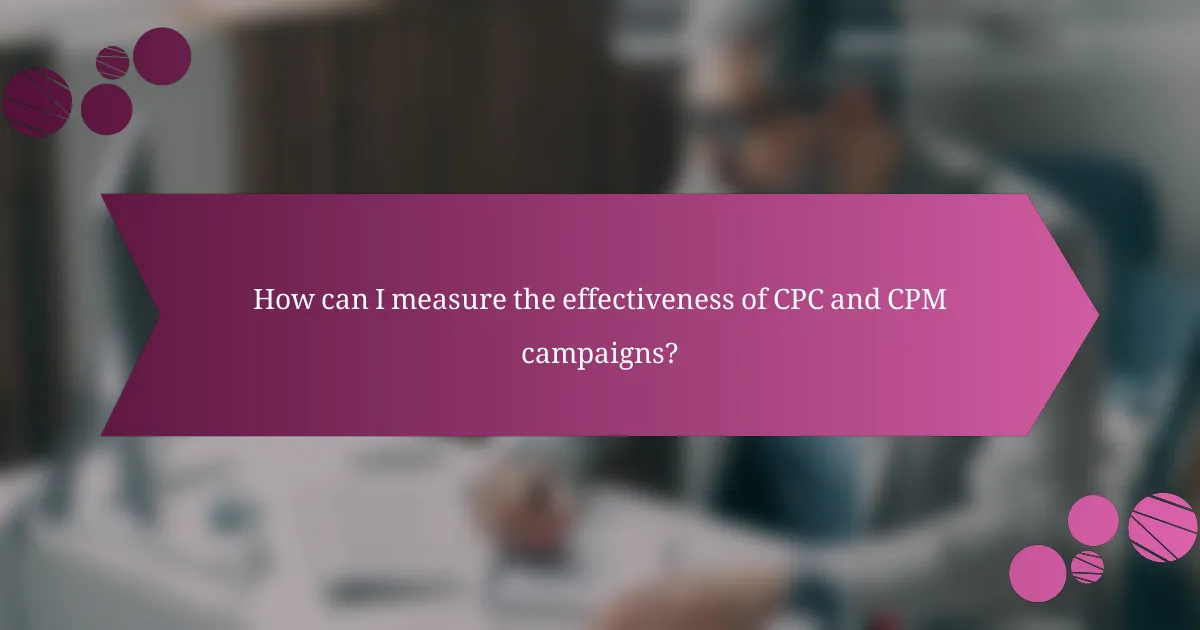
How can I measure the effectiveness of CPC and CPM campaigns?
To measure the effectiveness of CPC (Cost Per Click) and CPM (Cost Per Mille) campaigns, focus on key performance indicators (KPIs) such as conversion rates, click-through rates (CTR), and return on ad spend (ROAS). Analyzing these metrics will help you determine which budgeting model is yielding better results for your advertising goals.
Key Metrics for CPC Campaigns
For CPC campaigns, the primary metrics to track include click-through rate (CTR) and conversion rate. CTR indicates how often people click on your ad after seeing it, while conversion rate measures the percentage of those clicks that lead to a desired action, such as a purchase or sign-up. A higher CTR suggests effective ad copy and targeting, while a strong conversion rate indicates that your landing page is compelling.
To evaluate performance, aim for a CTR of around 2-5% as a benchmark, depending on your industry. If your conversion rate is below 2%, consider optimizing your ad or landing page to improve results.
Key Metrics for CPM Campaigns
In CPM campaigns, focus on impressions, reach, and engagement rates. Impressions show how many times your ad is displayed, while reach indicates the number of unique users who see your ad. Engagement rates, which include likes, shares, and comments, provide insight into how well your audience is responding to your content.
For CPM campaigns, a good engagement rate typically falls between 1-3%. If your engagement is low, reassess your targeting and creative elements to enhance audience interaction.
Comparing CPC and CPM Effectiveness
When comparing CPC and CPM effectiveness, consider your campaign objectives. CPC is often more effective for driving direct actions, such as sales or leads, while CPM is better suited for brand awareness and visibility. If your goal is immediate conversions, CPC may be the better choice; however, if you aim to build brand recognition, CPM could be more beneficial.
Evaluate the cost-effectiveness of each model by calculating your cost per acquisition (CPA) for CPC and your cost per thousand impressions for CPM. This will help you determine which model aligns best with your advertising strategy.





